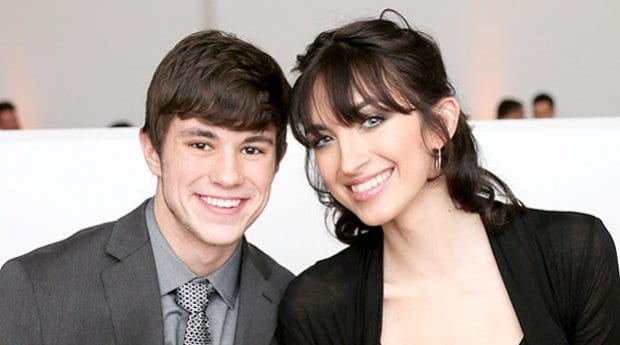As Toronto District School Board trustee Sam Sotiropolous sets science and culture back 100 years by claiming that transgender people are a medical fiction, your diligent transgender reviewer (who almost certainly exists) has been reading some actual transgender fiction — and non-fiction — intended for young adults. It’s a strangely satisfactory combination, if an infuriating one. Our elected chucklehead is spouting nonsense on television as I am wiping away a tear over Katie Rain Hill’s delicate description of her agreement with her mother that she will not kill herself if her mother advocated for her transition. She’s 13 when this conversation takes place and 19 as this book comes out.
Hill’s memoir of growing up and coming out is paired with that of Arin Andrews (18 as of writing) — her ex-boyfriend and a transgender man, a situation that titillated news shows (and evidently, publishers) to no end. “SEX SWAP COUPLE!” the tabloids blared, showing a photo of two attractive white young people from Oklahoma in a teenaged romance. Some kids meet at synagogue youth group, some in Dungeons & Dragons club; Katie and Arin met at transgender support group. As you do.
To be perfectly honest, it’s difficult to evaluate these books as literature. In the YA category, there’s not a great deal of non-fiction, mostly because it’s the rare 19-year-old with an interesting enough life to look back upon it. Both Rethinking Normal (Hill’s book) and Some Assembly Required (Andrews’s book) are reasonably good prose, if a bit workmanlike. They cover a lot of ground with honesty and thoughtfulness, if not a ton of style. Both describe slightly different but generally consonant (and resonant) journeys about gender and identity. Both linger on childhood games, relationships with parents, social development and the processes of identifying as transgender and then expressing that identity. And, both books will almost certainly save lives, keep families together and help trans students stay in school and fulfill their intellectual potential.
These may seem like wild claims, but rest assured that I can back them up. As a trans writer who writes about family and community, I receive email every week from parents and young people alike, desperate to see positive futures for young trans people. Hill and Andrews may not have created great works of literature, but their contribution to the wellness of transgender and genderqueer young people is tremendous. Beyond that, they show very clearly an important distinction in trans narratives. Andrews, as a youngster, is given quite a bit of latitude to be a tomboy, where Hill is ruthlessly brutalized for being a sissy. Misogyny, and transmisogyny, crop up repeatedly when comparing similar-age experiences between the two, making an efficient portrait of that particular insidious tentacle of anti-woman sentiment.
Contrasted against the YA fiction purported to be about trans young people, Some Assembly Required and Rethinking Normal are cast into a somewhat different light. Almost Perfect (Brian Katcher), Jumpstart the World (Catherine Ryan Hyde) and the most recent entry in the genre, Adam, by Ariel Schrag, all have the following two things in common: all of them delighted non-trans reviewers and all of them are books where the trans character is a plot device, telling us about the main, point-of-view character. I will tell you truthfully that I shouted and threw things while reading Adam, and they were not shouts of joy. They were shouts of outrage as I read unkind characterization after unkind characterization of beloved people and places and ideas through the eyes of a 17-year-old non-trans straight boy, pretending to be trans. It was excruciating. The misery was exacerbated by the fact that Schrag is a great storyteller and an excellent writer, so there was very little hope that people would just get bored with crap prose and a stuttering plot and give up.
This is my primary worry and great internal conflict about these works of literature: that the compelling one, the one written by Ariel Schrag, of The L Word, is what people will glean their trans information from. And the less-sensationalized but heartfelt works of Andrews and Hill will be read only by young trans people searching for meaning in their lives or their dutiful friends and family. I find this especially regrettable because, in the end, Hill’s “writing partner” (aka ghostwriter) is . . . Ariel Schrag. Oh, irony.
Since school is such a fraught ground, I’m gladder than I can express that Hill and Andrews have chosen to write their books and lay out the path they followed. For sure, I could have wished for a little more lyricism. Perhaps after they live to ripe old transgender ages, surrounded by their grandchildren, they’ll write another pair of books and demonstrate all they’ve learned — including some poetic sentence structure.


 Why you can trust Xtra
Why you can trust Xtra


